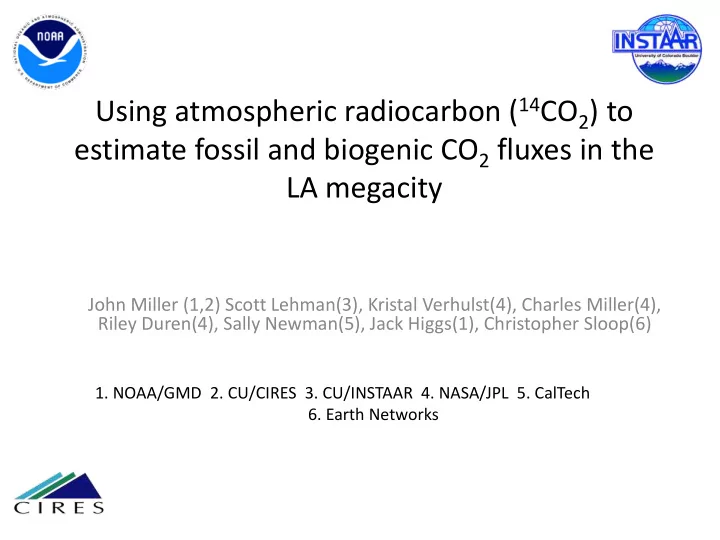

Using atmospheric radiocarbon ( 14 CO 2 ) to estimate fossil and biogenic CO 2 fluxes in the LA megacity John Miller (1,2) Scott Lehman(3), Kristal Verhulst(4), Charles Miller(4), Riley Duren(4), Sally Newman(5), Jack Higgs(1), Christopher Sloop(6) 1. NOAA/GMD 2. CU/CIRES 3. CU/INSTAAR 4. NASA/JPL 5. CalTech 6. Earth Networks
Project Goals • Ultimately: invert 14 C or CO 2 fos for FF emissions via CO (and other tracers.) • Proximately: compare observed CO 2 fos to transported inventories. Outline • Background on megacities and 14 CO 2 • Results and Analysis • Conclusions and Future work
Why Megacities? Large emissions and large signals! Duren and Miller, Nat. C.C., 2012 Megacity > 10 million; 2010 = 22; 2025 = 38
14 CO 2 : 12 CO 2 ( ∆ 14 C) is a robust tracer for fossil fuel fluxes: atmospheric ∆ 14 C looks just like fossil CO 2 . ∆ 14 C ff = -1000 per mil (i.e. zero 14 C) Scaling: -2.7 per mil ∆ 14 C = 1 ppm CO 2 -fossil ∆ 14 C CO 2-ff Includes ecosystems, oceans, nuclear Includes only fossil fuel power, cosmic rays, fossil fuel. Miller et al, 2012
CO 2 PBL enhancements (or depletions) can be partitioned into Ecosystem and Fossil fractions. CO 2 xs C obs = C bg + C fos + C bio ( ∆ C) obs = ( ∆ C) bg + ( ∆ C) fos + minor Measurement precision = 1.7 per mil ~ 1 ppm C fos ∆ ff = -1000 per mil; ∆ atm ~ +20 per mil
Context: NOAA/INSTAAR 14 CO 2 sites sensitive to significant fraction of Asian and North American emissions
LA Basin 14 CO 2 Sampling sites
CO 2 , CO and 14 CO 2 time series Background (NWR, MWO) Wow! USC Granada Hills CS Fullerton We’ll get to CO later…
CO 2 xs, fos and bio time series USC Granada Hills CS Fullerton
∆ 14 CO 2 -based source analysis -750 per mil 25% biological
CO 2 fos/bio source analysis • <CO 2 bio/CO 2 xs> = 0.27 (- 0.09/+0.18) • Also highly correlated (R = 0.8) common source location and transport Why is CO 2 bio as high as it is? • Ethanol in gasoline (10% of 50% of fuel sources) • Human Respiration (~ 1 % of fuel sources) • What is the rest? (~ 20%) • Urban Biosphere?
CO:CO 2 correlations – CO 2 fos
CO:CO 2 correlations – CO 2 xs
Transforming in situ CO to CO 2 fos Granada Hills in situ data • Just an example, for now… • Yellow represents mid- day hours – i.e. only CO 2 fos_syn = COxs/10.2 when our CO/CO 2 fos values are valid. • Evidence for diurnal variability in CO:CO 2
Wintertime biospheric CO 2 fraction averages ~40% of total CO 2 enhancement. N. America Europe Asia 56% 42% 50% 23% 41% 51% 19% 72% 21% 10% 52% 17% 25% 51% 45% Thanks to: K. Rozanski, M. Zimnoch (Poland); I. Levin (Germany); Morgan Lopez(France); L. Zhou (China); Korea-China 15 Center for Atmos. Res.
Conclusions and Future work 1. CO 2 xs ≠ CO 2 ff, even in L.A. 2. Significant CO 2 bio seems to be the rule – not the exception. 3. Remote-sensing and in situ approaches need to account for biospheric CO 2 . 4. δ 13 CO 2 measurements fuel type partitioning (oil v. gas) 5. Create continuos time series of CO 2 fos via CO 2 fos:CO ratios.
Mount Wilson Observations of 14C, CO2 and CO Nov – Feb (2011,2012) COxs:CO2_ff = 11.9 ppb/ppm COxs:CO2xs = 9.7 ppb/ppm Nov – Feb (2011, 2012) <Cbio/Ctot> = 15% (median) K.P. intercept = -818 +/-56 per mil
MWO and LA Basin comparison • Both show substantial Cbio, but MWO also shows substantial uptake. • MWO signals are weaker. • Differences between CO:CO2xs and CO:CO2ff are consistent with Cbio contributions, but… • … they are offset. Is this spatial or a time trend in combustion efficiency.
Future work • Sampling: – continue at 3 or 4 days per week for ~ 2 years – Add a summer and winter diurnal cycle sampling campaign – Switch PFPs to other sites (Compton?, Irvine?, San Bernardino?) • Measurement and QC: – Data flagging using in situ CO2, CO, ws and wd
14 CO 2 History Atmospheric Nuclear Weapons Testing Fossil Fuel 21
CO 2 PBL enhancements (or depletions) can be partitioned into Ecosystem and Fossil fractions. C obs = C bg + C fos + C bio Atm. CO 2 and 14 CO 2 ( ∆ C) obs = ( ∆ C) bg + ( ∆ C) fos + minor C ff ( 14 C=0 ) C bio ( 14 C ) Biospheric Fluxes • Fossil Fuel quantification • ‘w/o’ FF • Non CO2 GHG emission estimation inventories • Atmospheric transport validation
Fossil Fuel and ∆ 14 C • 14 C is produced from N in the stratosphere by cosmic rays. • It is oxidized to CO, then CO 2 • 14 C has a half-life of ~6000 years. • Thus, it is absent from fossil fuels, and thus an excellent tracer for these emissions. • In the USA, minor emissions from nuclear power plants • Also fluxes associated with gross C fluxes from oceans and terrestrial biosphere. U. Arizona AMS Lab 23
U.S. lower atmosphere data show expected depletions of 14 C Background (4000 m) 10 ppm Cff Downwind (300 m)
INSTAAR+UCI Measurement Precision Measurement made by • Accelerator Mass Spectrometry (AMS) at UC Irvine Precision = 1.6 per mil • Accuracy = < 0.5 per • mil (based on intercomparison of different labs) Lehman et al, 2013 ~7 years 25
Recommend
More recommend